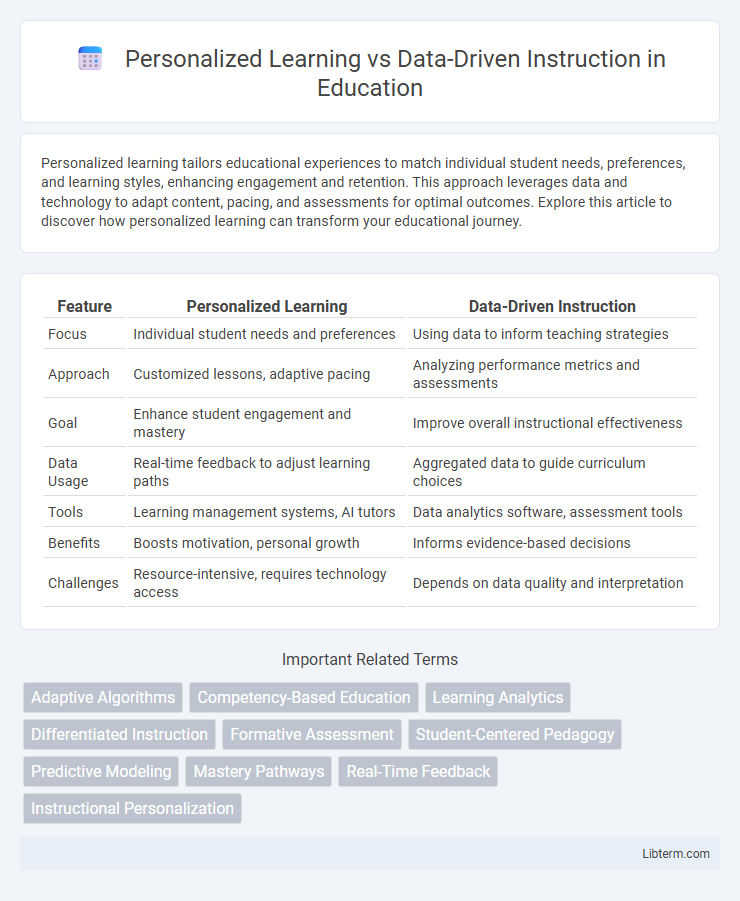Personalized learning tailors educational experiences to match individual student needs, preferences, and learning styles, enhancing engagement and retention. This approach leverages data and technology to adapt content, pacing, and assessments for optimal outcomes. Explore this article to discover how personalized learning can transform your educational journey.
Table of Comparison
| Feature | Personalized Learning | Data-Driven Instruction |
|---|---|---|
| Focus | Individual student needs and preferences | Using data to inform teaching strategies |
| Approach | Customized lessons, adaptive pacing | Analyzing performance metrics and assessments |
| Goal | Enhance student engagement and mastery | Improve overall instructional effectiveness |
| Data Usage | Real-time feedback to adjust learning paths | Aggregated data to guide curriculum choices |
| Tools | Learning management systems, AI tutors | Data analytics software, assessment tools |
| Benefits | Boosts motivation, personal growth | Informs evidence-based decisions |
| Challenges | Resource-intensive, requires technology access | Depends on data quality and interpretation |
Understanding Personalized Learning
Personalized learning tailors educational experiences to individual students' strengths, needs, and interests, promoting engagement and mastery. It uses adaptive technologies and ongoing assessments to customize content, pacing, and learning paths. This approach contrasts with data-driven instruction, which primarily relies on aggregated data to guide teaching decisions for groups rather than individual customization.
Defining Data-Driven Instruction
Data-driven instruction refers to the systematic use of student performance data to guide teaching strategies, curriculum adjustments, and intervention plans, ensuring that educational decisions are evidence-based and targeted. Unlike personalized learning, which tailors educational experiences to individual learner preferences and needs, data-driven instruction emphasizes analyzing quantifiable metrics such as assessment results, attendance, and engagement levels. This approach enables educators to identify learning gaps quickly and apply research-backed practices to improve academic outcomes efficiently.
Core Principles of Each Approach
Personalized learning centers on tailoring educational experiences to individual student interests, learning styles, and paces, fostering engagement and autonomy as core principles. Data-driven instruction emphasizes using quantitative data, like assessment results and performance metrics, to inform teaching decisions and improve outcomes systematically. Both approaches prioritize student growth but differ in that personalized learning customizes pathway flexibility, while data-driven instruction relies on empirical evidence for targeted interventions.
Key Differences Between Personalized Learning and Data-Driven Instruction
Personalized Learning centers on tailoring educational experiences to individual student needs, preferences, and interests, promoting autonomy and engagement through adaptive content and pacing. Data-Driven Instruction relies on analyzing student performance data to inform teaching strategies, focusing on identifying learning gaps and adjusting curriculum based on measurable outcomes. The key difference lies in Personalized Learning's emphasis on learner-centered customization versus Data-Driven Instruction's focus on systematic data analysis to drive instructional decisions.
Benefits of Personalized Learning in the Classroom
Personalized learning enhances student engagement by tailoring lessons to individual strengths, weaknesses, and learning styles, promoting deeper understanding and retention of material. It supports differentiated instruction, allowing educators to address diverse needs, which leads to improved academic outcomes and motivation. The adaptability of personalized learning fosters self-paced progress, encouraging students to take ownership of their education and develop critical thinking skills.
Advantages of Data-Driven Instruction for Educators
Data-driven instruction empowers educators by providing precise insights into student performance, enabling targeted interventions that address individual learning gaps. This approach enhances decision-making through continuous assessment data, fostering adaptive teaching strategies that improve overall academic outcomes. Leveraging analytics also streamlines resource allocation, ensuring effective use of time and materials in diverse classroom environments.
Challenges and Limitations of Both Methods
Personalized learning faces challenges such as scalability and the need for extensive teacher training to effectively tailor instruction to individual student needs. Data-driven instruction often struggles with data quality issues and the risk of oversimplifying student performance through standardized metrics. Both methods require careful integration of technology and human judgment to avoid inequities and ensure meaningful educational outcomes.
Integrating Personalized Learning with Data-Driven Strategies
Integrating personalized learning with data-driven instruction enhances educational outcomes by tailoring content to individual student needs using real-time analytics and assessment data. Adaptive learning platforms leverage detailed performance metrics to customize learning paths, ensuring targeted support and pacing adjustments. This fusion optimizes engagement and mastery, fostering a more efficient and responsive learning environment.
Real-World Examples and Case Studies
Personalized learning tailors education to individual student needs using adaptive technologies, as demonstrated by DreamBox Learning's math platform, which customizes lessons based on real-time student performance data. Data-driven instruction emphasizes analyzing large datasets to inform teaching strategies, exemplified by KIPP charter schools, which utilize continuous assessment data to adjust curriculum and improve student outcomes. Both approaches leverage technology and data analytics to enhance educational effectiveness, with case studies showing improved engagement and academic achievement.
Future Trends in Educational Innovation
Personalized learning increasingly leverages artificial intelligence and adaptive algorithms to tailor educational content to individual student needs, enhancing engagement and improving outcomes. Data-driven instruction integrates real-time analytics from diverse sources, enabling educators to make informed decisions that address learning gaps more effectively. Future trends indicate a convergence of these approaches, supported by advanced technologies such as machine learning and immersive virtual environments, which promise to revolutionize educational innovation through more precise and dynamic teaching strategies.
Personalized Learning Infographic

 libterm.com
libterm.com